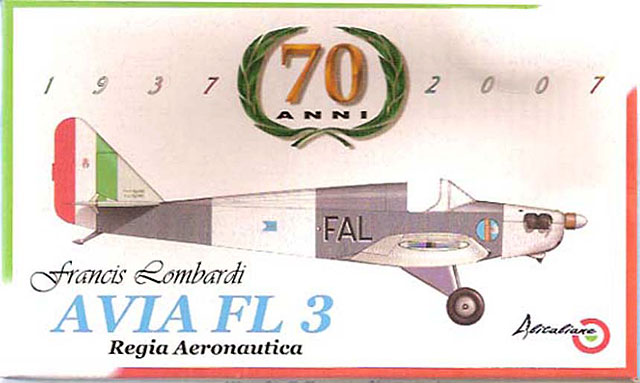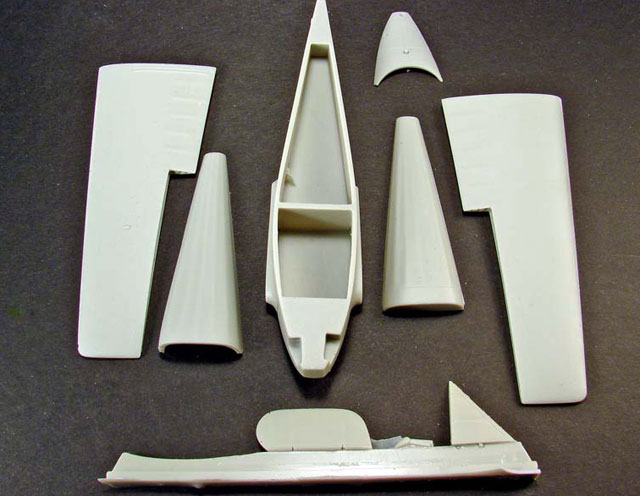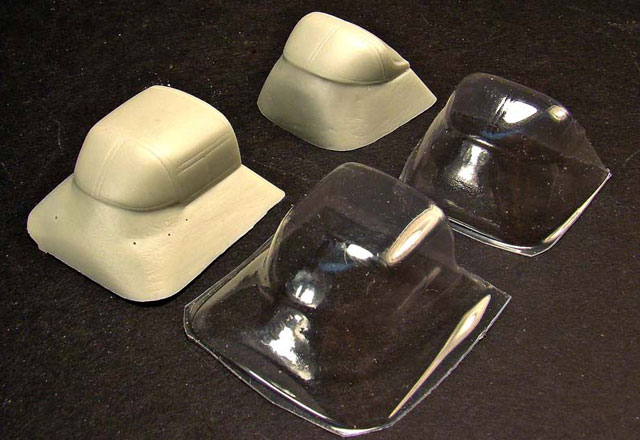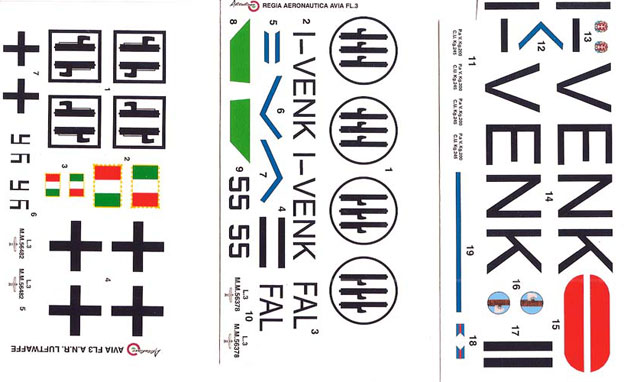|
Francis Lombardi
AVIA FL 3

Alitaliane, 1/48
S
u m m a r y
|
| Catalogue Number: |
AIK 48004 -
Francis Lombardi AVIA FL 3 |
| Scale: |
1/48 |
| Contents and Media: |
28 pieces in
gray colored resin, four etched brass and two different style clear vac-form
canopies with resin forms. Instructions, painting guide and decal sheet
for 3 aircraft (2 additional decals for non-referenced aircraft). |
| Price: |
60 Euros. Available from MISTERKIT. |
| Review Type: |
FirstLook - In Box |
| Advantages: |
A nicely done
model of a somewhat obscure aircraft. Good marking selection. |
| Disadvantages: |
Need for
clean up on the fuselage. Inkjet printed decals. Requires use of
cyanoacrylic (super / crazy) glue and /or two-part epoxy. |
| Recommendation: |
Highly recommended for modelers who
have experience with resin kits and parts. |
Reviewed by Steven "Modeldad" Eisenman

HyperScale is proudly supported by Squadron
One can usually count on Hyperscalers to remember
important dates in aviation history. But I am surprised that no one has
acknowledged the anniversary for which this kit was issued. Did no one
remember the 70th anniversary of the development of the
A.V.I.A. (Francis Lombardi) FL 3? I would have even thought it would
have been on someone’s wish list!
Tongue-in-cheek humor aside, the FL 3 must be one
of the least known aircraft of the Second World War and post-war
period. It barely rates footnote status in John Thompson’s
Italian Civil & Military Aircraft 1930-1945, and from which I
quote:
The Azionaria Vercellese Industrie Aeronautiche of
Vercelli was a small firm, which produced a number of designs by the
well known aviator Francis Lombardi. The FL 3 two-seat lightplane,
first produced before the war and widely used in postwar flying, was a
low wing monoplane powered by an 80 h.p. C.N.A. D.4 four-cylinder
horizontally-opposed air-cooled engine. In 1948 A.V.I.A. was absorbed
by Francis Lombardi & c., which continued to build the FL 3. During the
war a few FL 3’s, with airscrews removed, were used as training
gliders. In 1941-42, when the Regia Aeronautica was showing interest in
military cargo gliders, it was necessary to acquaint pilots with sinking
speeds higher than those of sport gliders.
This is a very basic resin kit. Detail is just
adequate for a kit of this type. But the fabric surfaces are quite
nicely done. Some clean up will be required on the bottom of the
fuselage and on the lower-sides of the fuselage top.
The gear legs are finely molded and will require
great care in removing from the mold block. There is also an issue of
the solid piece between the gear legs. It appears that some FL 3’s had
an open framework for the gear legs, while others had sheet metal within
the legs. The marking guide shows that aircraft I-VENK had closed gear
legs. But it is not clear as to aircraft FAL, as the box art shows them
closed, while the marking guide shows them open.
The kit comes with two delicate vac-formed
windshields for two different styles (actually 3) of windshields. What
is most unusual is that the clear parts were mounted on what appears to
be the resin mold for the clear parts. If nothing else, the resin
pieces provide plenty of protection against crushing of the clear
parts. As only one of each type of windshield is provided, those forms
may come in handy for making a replacement.

Click
the thumbnails below to view larger images:
[../../../photogallery/photo00016382/real.htm]
As to the type of windshield that is to be used,
the smaller of the two clear parts is for aircraft Black 55 and FAL.
This is merely a windshield with small side window. The other clear
part, the larger of the two, is for aircraft I-VENK. Use of this part
will require that the top be removed from the clear part leaving only
the full-length side windows.
It is interesting to note that the larger clear
part can be used for a fully enclosed cockpit. This appears to be the
subject of Alitaliane’s other FL 3 kit, 48004. However, a fully
enclosed cockpit aircraft may be able to be made from Kit 48003, as my
sample also came with the deeper fuselage top.

Interestingly, the kit has attachment points for
the main wing to fuselage join. A test fit shows that it may be better
to remove the stubs on the wings, so as to get a better alignment of the
parts. On my sample, when using the attachment points, the wings are a
bit low and to the rear, with regard to the wing root on the fuselage.
The kit comes with separate ailerons. Remember, one up and one down, if
not level.
Being a trainer, and a small resin kit, the cockpit
is a little sparse to say the least. There is merely the seat,
instrument panels and control sticks.
I do not have much to go on in determining the
accuracy of this kit. But according to the Thompson book, the wingspan
of the FL. 3 is 32 feet 3 ¾ inches. The kit’s wings measure about four
scale inches short of that.
When working with resin kits I like to use slow
cure CA glue. This allows for a bit of time to position the part, as
will be required for the fuselage top and main wings.
Markings
The decals that come with the kit are of the inkjet
waterslide type printed on a continuous piece of film. My sample also
came with the markings for kit number 48004, which is for a Luftwaffe
and an ANR aircraft. There are a couple of sheets that look as if
nothing is printed on them. Be careful, these two pieces of paper have
the white backgrounds for the national markings and the white outline
for aircraft FAL.

The painting guide is also not very informative as
to the color call-outs.
Black 55: Scuola Volo Senza Motore Cameri 1942.
The aircraft appears to be overall Ivory ( Cachi Avorio Chiaro / Bianco
Avorio FS approx. 33613). But the notes also indicate “Snow”. Snow is
a bright white. I’d go with Ivory. It has a tri-color fin and rudder,
for which red and green decals are provided. The white will have to be
painted. It is not clear, but the cowling cover could be Ivory, Snow or
natural metal.
I-VENK: Militare “Arlecchino”. The aircraft is in
overall light gray. But which light gray is not indicated. My guess
would be pre-table 10 Grigio Mimetico (FS approx. 36231). The aircraft
has wide white bands around the fuselage and wings. The fin and rudder
are in the tri-color. The engine cowl is either white or natural
metal.
FAL: Scuola Volo Falconara. Based on the cover
art, this aircraft appears to be a dark gray top with light gray
underside. It is possible that the wing tops were green. Once again, I
would guess the dark grey is possibly Grigio Azzuro Scuro 3 (FS Approx.
36118). The underside would be Grigio Azzurro Chiaro 1. If the wing
tops were in green, then Verde Mimetico 3 (FS approx. 34102) or Verde
Oliva Scuro (FS approx. 34052). There is a wide white band on the
fuselage and narrower white bands around the wings. The fin and rudder
are in the tri-color. The cowling may be either white or natural
metal.
If all 48003 kits come with the Luftwaffe and ANR
markings, the Luftwaffe aircraft would be in dark green top (Verde
Oliva Scuro) with light gray underside (Grigio Azzurro Chiaro). The ANR
aircraft might be similar to the Luftwaffe aircraft, but with sand
colored blotches all over the upper surface. A profile of an ANR FL 3
can be seen on page 203 of Camouflage and Markings of the
Aeronautical Nazionale Repubblicana 1943-1945 by D’Amico and
Valentini.
I am sure many modelers will be put off by the
price of this little kit. It will also probably have limited appeal –
those interested in Italian liaison and training aircraft. But don’t
forget that this aircraft was also used in the post-war period, so a
number of other schemes could be done.
All things considered, this is a nice addition to
the world of 1/48 (obscure) aircraft.
Recommended.
A simple Google search for “Avia FL
3” will turn up some interesting images.
Thanks to Maurizio Di Terlizzi for the
review sample.
Review and Images Copyright © 2007 by
Steven Eisenman
Page Created 11 January, 2007
Last updated 24 December, 2007
Back to HyperScale Main Page
Back to Reviews Page
|
Home
| What's New |
Features |
Gallery |
Reviews |
Reference |
Forum |